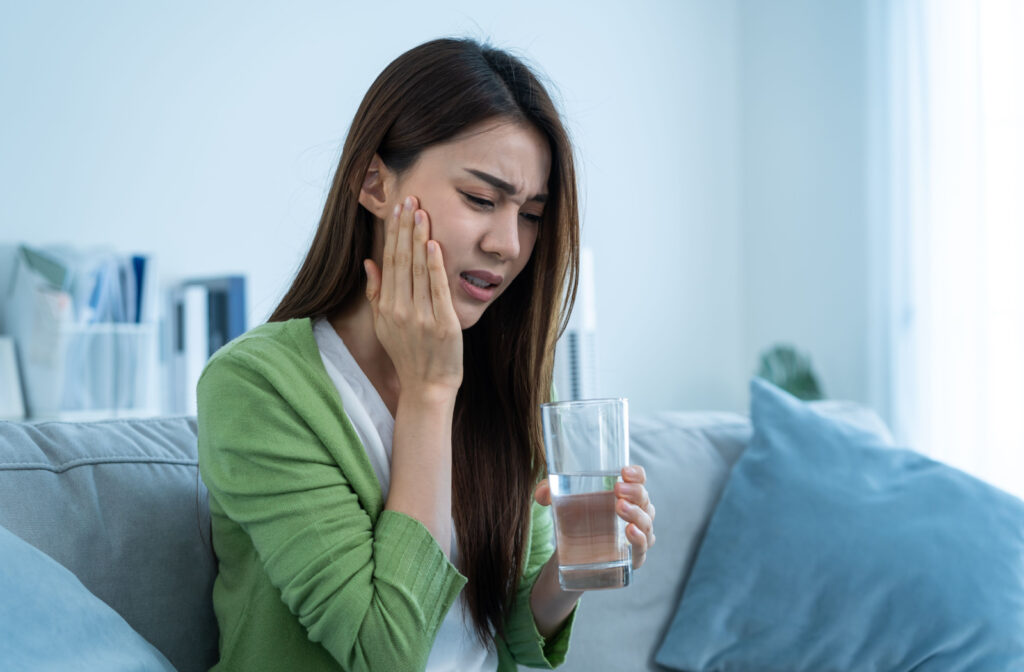A dental filling is a common procedure for treating cavities and restoring damaged teeth. While it is a relatively simple procedure, many people experience teeth sensitivity after getting a filling and wonder why.
After getting a filling, you can experience sensitivity as a result of irritation and inflammation near the nerves in the inner layers of your teeth. Your sensitivity should fade over time, but when you visit us for a filling, our dental team can also help provide solutions to manage the discomfort and offer advice to help make the rest of the day’s eating and drinking more bearable.
What Triggers Sensitivity After a Filling?
A filling can fix issues like pain and sensitivity that may have been caused by a cavity, but immediately after a filling, it can take some time to feel back to normal.
Post-filling sensitivity can be triggered by several factors, including:
- Temperature
- Pressure
- Depth of the cavity
Thermal Sensitivity
A filling may cause some initial thermal sensitivity. This happens when your tooth reacts to a hot or cold temperature after the filling procedure. While the nerves inside your tooth recover and adapt to your filling, hot coffee, cold water, and even breathing in winter air could cause discomfort.
Pressure Sensitivity
If your filling is on a biting surface, the pressure you exert on that tooth immediately following your filling may cause some sensitivity. In some cases, a filling can alter your jaw’s bite. This can also happen if a filling is too high or not flush with your tooth’s surface.
When your jaw closes, your filling might be the first point of contact, leading to discomfort or pain. If that happens, we can adjust your filling to relieve this sensitivity.
Depth of Decay
Sometimes, teeth can be sensitive after a filling because of the depth of decay or damage to the tooth structure. Pulpitis, inflammation in pulp deep in a tooth, can also occur when your tooth has suffered extensive trauma from:
- A cracked or fracture
- A deep cavity in the pulp layer of your tooth
- Multiple fillings
A filling may restore your tooth, but it may still feel sensitive because of the extent of the damage. If your tooth continues to be sensitive, you may need a root canal treatment to remove damaged or infected tooth material.
How to Minimize Discomfort After a Filling
While some sensitivity is common, there are management techniques you can use to try to minimize the discomfort you may experience after a filling. Some of the following methods may help you recover:
Don’t Chew on the Filling
It’s essential to avoid putting pressure on a filling for the first few hours after the procedure. Chewing on a filling can cause damage and prolong the healing process. To maintain the integrity of a filling, you should:
- Chew and bite down carefully in another part of your mouth
- Avoid hard or sticky foods, including gum
- Eat slowly
- Avoid sugar and extreme temperatures
Stick to soft foods such as soup, smoothies or mashed potatoes until the numbness from the procedure has worn off. You can then gradually introduce solid foods as you start to feel comfortable.
Use Over-The-Counter Pain Relievers
Over-the-counter pain relievers may help manage discomfort after a filling. Pain relief medications such as acetaminophen or ibuprofen can help reduce swelling and relieve pain. Be sure to follow the recommended dosage and always speak with your doctor before taking new medications to avoid any adverse side effects.
Apply Cold Therapy
When the numbness wears off after a filling, you may feel some swelling and irritation in the treated area. To reduce discomfort, apply an ice pack or a cold compress to the area outside of your face where the filling was done. Leave it for 10–15 minutes, then remove it for at least 10 minutes and repeat as needed.
Talk to Your Dentist
If discomfort persists after a few days, don’t hesitate to contact us. We may need to adjust the filling to relieve the pain or perform further treatment if there is an infection underneath the filling.

Prevent Cavities with Regular Dental Cleanings
One of the best ways to prevent discomfort from fillings is to avoid cavities. You should visit your dentist every 6 months for a professional dental cleaning and exam—and don’t forget to follow a healthy oral hygiene routine at home. Regular brushing and flossing are essential for avoiding cavities.Schedule an appointment with Shawnessy Dental to help your smile stay happy and healthy—and learn more about managing cavities and discomfort from fillings.


